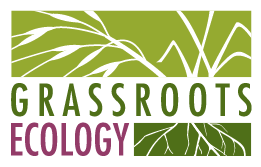Native Plant of the Month: Sedges
Sedges alongside native grasses and forbs like common yarrow in the Foothills Nature Preserve lawn replacement project.
At first glance, most sedges (Carex spp.) look like grass, but they are in fact a separate group of plants! Run your fingers along the stalk of a sedge, and you will feel three distinct ridges created by the stem’s triangular cross-section (hence the mnemonic phrase “sedges have edges”). By contrast, grass stems are round, hollow, and have occasional joints that resemble knees or elbows.
Sedges are often found in moist areas, such as riverbanks, wet meadows, and marshes, though some species grow in drier habitats, too. Indigenous tribes throughout California traditionally cultivate and till beds of certain sedge species, such as Santa Barbara sedge (Carex barbarae), promoting the growth of long, straight rhizomes (underground stems) that are prized for basketry. Sedge rhizomes are also excellent at holding soil in place and preventing erosion along slopes or streams.
Despite the subtle differences between sedges and grasses, many sedges can be excellent substitutes for grass lawns or meadows. Given the wide variety of sedges in California, you will likely find a native sedge species that fits your garden’s sun, water, and soil conditions. Below are three sedges popular in landscaping:
Sand dune sedge (Carex pansa)
As indicated by its name, sand dune sedge is native to sand dunes on the California coast. It spreads to form a lumpy meadow about 1 foot tall, but can be mowed if a lawn-like look is desired. Dune sedge does best in well-draining soil and sunny but mild climate conditions, similar to its native coastal habitat. In hotter inland locations, more frequent irrigation is needed to keep the plant green through the summer. This species can tolerate light foot traffic.
Clustered field sedge (Carex praegracilis)
Clustered field sedge is an adaptable species that is widespread throughout North America. It typically grows in sunny, seasonally wet areas and goes dormant in the drier months, but can be kept green with moderate irrigation. Like dune sedge, it spreads and can be used as a meadow or lawn suitable for light foot traffic. However, compared to dune sedge, it tolerates a wider variety of soil types and does better in inland climates. Its spreading habit and dense rhizomes make it a great option for stabilizing moist slopes.
Clustered field sedge is a great lawn substitute or meadow plant.
Foothill sedge in a bioretention area.
Foothill sedge (Carex tumulicola)
The most drought tolerant species in our list, Foothill sedge grows in drier habitats like meadows, coastal prairies, and woodlands (though it still prefers some summer water and/or partial shade in hotter climates). Its rhizomes do not spread as quickly as the other two species, tending to grow in clumps about 1 foot tall and 2 feet wide. It can be planted in masses on its own or around other plants, creating a luscious, evergreen groundcover. Cut them to the base in fall to encourage new growth the following year.
Where to Find Sedges
Grassroots Ecology staff and volunteers have planted sedges in the Foothills Nature Preserve lawn replacement, in bioretention areas in the Southgate neighborhood of Palo Alto, and at Cooley Landing. Our nursery grows native plants including sedges using seeds and cuttings carefully sourced from local watersheds. Check out our latest inventory for online sales here:
By Stanley Gu, Ecologist II





